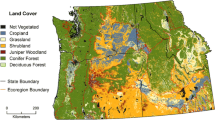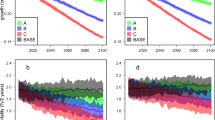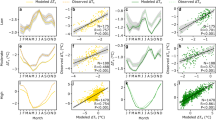Abstract
Ecosystem models typically use input temperature and precipitation data generated stochastically from weather station means and variances. Although the weather station data are based on measurements taken over a few decades, model simulations are usually on the order of centuries. Consequently, observed periodicities in temperature and precipitation at the continental scale that have been correlated with largscale forcings, such as ocean-atmosphere dynamics and lunar and sunspot cycles, are ignored. We investigated how these natural climatic fluctuations affect aboveground biomass in ecosystem models by incorporating some of the more pronounced continental-scale cycles in temperature (4, 11, 80, 180 year periods) and precipitation (11 and 19 year periods) into models of three North American forests (using LINKAGES) and one North American grassland (using STEPPE). Even without inclusion of periodicities in climate, long-term dynamics of these models were characterized by internal frequencies resulting from vegetation birth, growth and death processes. Our results indicate that long-term temperature cycles result in significantly lower predictions of forest biomass than observed in the control case for a forest on a biome transition (northern hardwoods/boreal forest). Lower-frequency, higher-amplitude temperature oscillation caused amplification of forest biomass response in forests containing hardwood species. Shortgrass prairie and boreal ecosystems, dominated by species with broad stress tolerance ranges, were relatively insensitive to climatic oscillations. Our results suggest periodicities in climate should be incorporated within long-term simulations of ecosystems with strong internal frequencies, particularly for systems on biome transitions.
Similar content being viewed by others
References
Ågren, G.I., McMurtrie, R.E., Parton, W.J., Pastor, J.P. and Shugart, H.H. 1991. State-of-the-art of models of production-decomposition linkages in conifer and grassland ecosystems. Ecol. Applic. 1: 118–138.
Allen, T.H.F., O'Neill, R.V. and Hoekstra, T.W. 1984. Interlevel Relations in Ecological Research and Management: Some Working Principles from Hierarchy Theory. General Technical Report RM-110. Fort Collins, CO: USDA-Rocky Mountian Forest and Range Experimental Station.
Bonan, G.B. and Sirois, L. 1992. Air temperature, tree growth, and the northern and southern range limits to Picea mariana. J. Veg. Sci. 3: 495–506.
Botkin, D.B., Janak, J.F. and Wallis, J.R. 1972. Some ecological consequences of a computer model of forest growth. J. Ecol. 60: 849–872.
Broecker, W.S. 1975. Climatic change: are we on the brink of a pronounced global warming? Science 189: 460–463.
Brown, R.G. 1983. Introduction to Random Signal Analysis and Kalman Filtering. John Wiley & Sons, New York.
Burke, I.C., Kittel, T.G.F., Lauenroth, W.K., Snook, P. and Yonker, C.M. 1991. Regional analysis of the central Great Plains: sensitivity to climate variability. BioSci. 41: 685–692.
Burroughs, W.J. 1992. Weather Cycles: Real or Imaginary? Cambridge University Press, Cambridge.
Cale, W.G., Henebry, G.M. and Yeakley, J.A. 1989. Inferring process from pattern in natural communities. BioSci. 39: 600–605.
Coffin, D.P. and Lauenroth, W.K. 1990. A gap dynamics simulation model of succession in a semiarid grassland. Ecol. Mod. 49: 229–266.
Coffin, D.P. and Lauenroth, W.K. 1991. Effects of competition on spatial distribution of roots of blue grama. J. Range Mgmt. 44: 68–71.
Coffin, D.P. and Urban, D.L. 1993. Implications of natural history traits to system-level dynamics: comparisons of a grassland and a forest. Ecol. Mod. 67: 147–178.
Cohen, Y. and Pastor, J.P. 1991. The responses of a forest model to serial correlations of global warming. Ecol. 72: 1161–1165.
Currie, R.G. and O'Brien, D.P. 1988. Periodic 18.6-year and cyclic 10 to 11 year signals in Northeastern United States precipitation data. J. Clim. 8: 255–281.
Currie, R.G. and O'Brien, D.P. 1990. Deterministic signals in precipitation in the Northwestern United States. Water Resour. Res. 26: 1649–1656.
Davis, M.B. and Botkin, D.B. 1985. Sensitivity of cooltemperate forests and their fossil pollen record to rapid temperature change. Quat. Res. 23: 237–240.
DeAngelis, D.L. and Waterhouse, D.C. 1987. Equilibrium and nonequilibrium concepts in ecological models. Ecol. Monog. 57: 1–21.
DeAngelis, D.L., Post, W.M. and Travis, C.C. 1986. Positive Feedback in Natural Systems. Springer-Verlag, N.Y.
Dwyer, R.L. and Kremer, J.N. 1983. Frequency-domain sensitivity analyses of an estuarine ecosystem simulation model. Ecol. Mod. 18: 35–54.
Emanuel, W.R., West, D.C. and Shugart, H.H. 1978. Spectral analysis of forest model time series. Ecol. Mod. 4: 313–326.
Enfield, D.B. 1989. El Niño, past and present. Rev. Geophys. 27: 159–187.
Friend, A.D., Shugart, H.H. and Running, S.L. 1993. A physiology-based gap model of forest dynamics. Ecol. 74: 792–797.
Fuller, W.A. 1976. Introduction to Statistical Time Series. John Wiley & Sons, N.Y.
Gosz, J.R. and Sharpe, P.J.H. 1989. Broad-scale concepts for interactions of climate, topography, and biota at biome transitions. Land. Ecol. 3: 229–243.
Holdsworth, G., Krouse, H.R. and Nosal, M. 1992. Ice core climate signals from Mount Logan, Yukon, A.D. 1700–1897. In Climate Since A.D. 1500. pp. 483–504. Edited by R.S. Bradley and P.D. Jones. Routledge, London.
Jassby, A.D. and Powell, T.M. 1990. Detecting changes in ecological time series. Ecol. 71: 2044–2052.
Jones, P.D., Wigley, T.M.L. and Wright, P.B. 1986. Global temperature variations between 1861 and 1984. Nature 322: 430–434.
Kelly, P.M. and Wigley, T.M.L. 1992. Solar cycle length, green-house forcing and global climate. Nature 360: 328–330.
Kerr, R.A. 1984. Moon influences western U.S. drought. Science 224: 587.
Kienast, F. 1991. Simulated effects of increasing atmospheric CO2 and changing climate on the successional characteristics of Alpine forest ecosystems. Land. Ecol. 5: 225–238.
Lauenroth, W.K., Urban, D.L., Coffin, D.P., Parton, W.J., Shugart, H.H., Kirchner, T.B. and Smith, T.M. 1993. Modeling vegetation structure-ecosystem process interactions across sites and biomes. Ecol. Mod. 67: 49–80.
Lean, J. and Rind, D. 1994. Solar variability: implications for global change. Eos. Trans. AGU 75: 1, 5–7.
Michaels, P.J. and Hayden, B.P. 1987. Modeling the climate dynamics of tree death. BioSci. 37: 603–610.
Mitchell, J.M. 1976. An overview of climatic variability and its causal mechanisms. Quat. Res. 6: 481–493.
Neilson, R.P. 1986. High-resolution climatic analysis and south-west biogeography. Science 232: 27–34.
Neilson, R.P., King, G.A. and Koerper, G. 1992. Toward a rulebased biome model. Land. Ecol. 7: 27–43.
O'Neill, R.V., DeAngelis, D.L., Waide, J.B. and Allen, T.H.F. 1986. A Hierarchical Concept of Ecosystems. Princeton University Press, Princeton, New Jersey.
O'Neill, R.V., Johnson, A.R. and King, A.W. 1989. A hierarchical framework for the analysis of scale. Land. Ecol. 4: 193–205.
Overpeck, J.T., Rind, D. and Goldberg, R. 1990. Climate-induced changes in forest disturbance and vegetation. Nature 343: 51–53.
Pastor, J.P. and Post, W.M. 1985. Development of a Linked Forest Productivity-Soil Process Model. ORNL/TM-9519 Oak Ridge National Laboratory, Oak Ridge, Tennessee, USA.
Pastor, J.P. and Post, W.M. 1986. Influence of climate, soil moisture, and succession on forest carbon and nitrogen cycles. Biogeochem. 2: 3–27.
Pastor, J.P. and Post, W.M. 1988. Response of northern forest to CO2 induced climate change. Nature 334: 55–58.
Platt, T. and Denman, K.L. 1975. Spectral analysis in ecology. Ann. Rev. Ecol. Syst. 6: 189–210.
Quinn, W.H. and Neal, V.T. 1992. The historical record of El Niño events. In Climate Since A.D. 1500. pp. 623–648. Edited by R.S. Bradley and P.D. Jones. Routledge, London.
Rastetter, E.B., Ryan, M.G., Shaver, G.R., Melillo, J.M., Nadelhoffer, K.J., Hobbie, J.E. and Aber, J.D. 1991. A general biogeochemical model describing the responses of the C and N cycles in terrestrial ecosystems to changes in CO2, climate and N deposition. Tree Physiol. 9: 101–126.
Rind, D. and Overpeck, J. 1994. Hypothesized causes of decadal-to-century climate variability: Climate model results. Quat. Sci. Rev. in press.
Ropelewski, C.F. and Halpert, M.S. 1986. North American precipitation and temperature patterns associated with the El Niño/Southern Oscillation (ENSO). Mon. Weather Rev. 114: 2352–2362.
Running, S.W. and Coughlan, J.C. 1988. A general model of forest ecosystem processes for regional applications I. Hydrological balance, canopy gas exchange and primary production processes. Ecol. Mod. 42: 125–154.
Sala, O.E. and Lauenroth, W.K. 1982. Small rainfall events: an ecological role in semiarid regions. Oecologia (Berlin) 53: 301–304.
Sala, O.E., Lauenroth, W.K. and Parton, W.J. 1992. Long-term soil water dynamics in the shortgrass steppe. Ecol. 73: 1175–1181.
SAS/ETS User's Guide. 1982. Edited by A.A. Ray. SAS Institute, Cary, North Carolina.
Schlesinger, M.E. and Ramankutty, N. 1992. Implications for global warming of intercycle solar irradiance variations. Nature 360: 330–333.
Shugart, H.H. 1984. A Theory of Forest Dynamics. Springer-Verlag, New York.
Shugart, H.H. 1987. Dynamic ecosystem consequences of tree birth and death patterns. BioSci. 37: 596–602.
Shugart, H.H. and West, D.C. 1977. Development of an Appalachian deciduous forest succession model and its application to assessment of the impact of the chestnut blight. J. Env. Mgmt. 5: 161–170.
Shugart, H.H. and West, D.C. 1981. ong-term dynamics of forest ecosystems. Amer. Scientist 69: 647–652.
Shugart, H.H. and Urban, D.L. 1989. Factors affecting the relative abundance of forest tree species. In Toward a More Exact Ecology. Edited by P.J. Grubb and J.B. Whittaker. Blackwell Scientific Publications, Oxford.
Shugart, H.H., Emanuel, W.R., West, D.C. and DeAngelis, D.L. 1980. Environmental gradients in a simulation model of a beech-yellow-poplar stand. Math. BioSci. 50: 163–170.
Smith, T.M. and Urban, D.L. 1988. Scale and resolution of forest structural pattern. Vegetatio 74: 143–150.
Stocker, T.F. and Mysak, L.A. 1992. Climatic fluctuations on the century time scale: a review of high-resolution proxy data and possible mechanisms. Clim. Change 20: 227–250.
Urban, D.L., O'Neill, R.V. and Shugart, H.H. 1987. Landscape ecology. BioSci. 37: 119–127.
Vines, R.G. 1982. Rainfall patterns in the western United States. J. Geophys. Res. 87: 7303–7311.
Weinstein, D.A. 1992. Use of simulation models to evaluate the alteration of ecotones by global carbon dioxide increases. In Landscape Boundaries: Consequences for Biotic Diversity and Ecological Flows, pp. 379–393. Edited by A.J. Hanson and F. di Castri. Springer-Verlag, New York.
Wigley, T.M.L. and Raper, S.C.B. 1990. Natural variability of the climate system and detection of the greenhouse effect. Nature 344: 324–327.
Yeakley, J.A. and Cale, W.G. 1991. Organizational levels analysis: a key to understanding processes in natural systems. J. Theor. Biol. 149: 203–216.
Zar, J.H. 1984. Biostatistical analysis. 2nd ed. Prentice-Hall, Englewood Cliffs, New Jersey.
Author information
Authors and Affiliations
Rights and permissions
About this article
Cite this article
Yeakley, J.A., Moen, R.A., Breshears, D.D. et al. Response of North American ecosystem models to multi-annual periodicities in temperature and precipitation. Landscape Ecol 9, 249–260 (1994). https://doi.org/10.1007/BF00129236
Issue Date:
DOI: https://doi.org/10.1007/BF00129236




